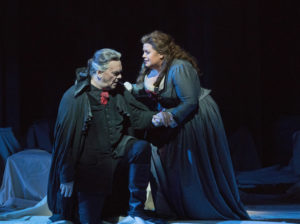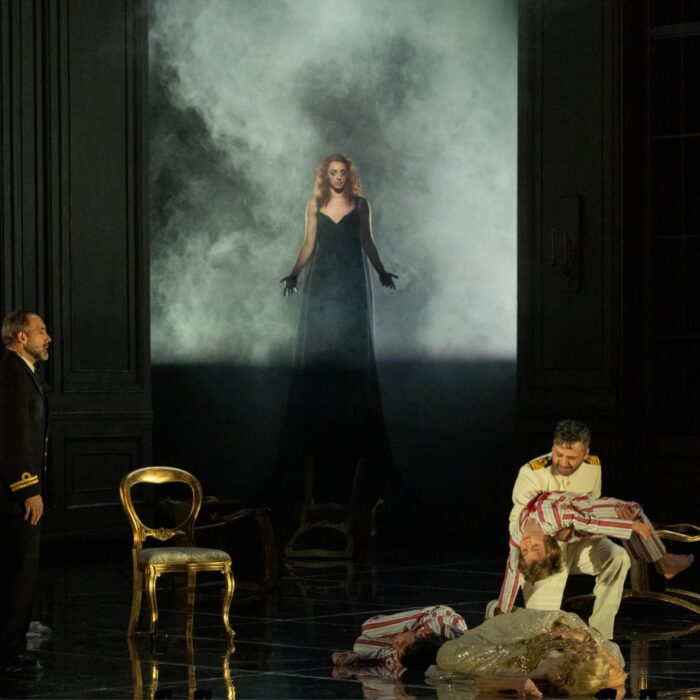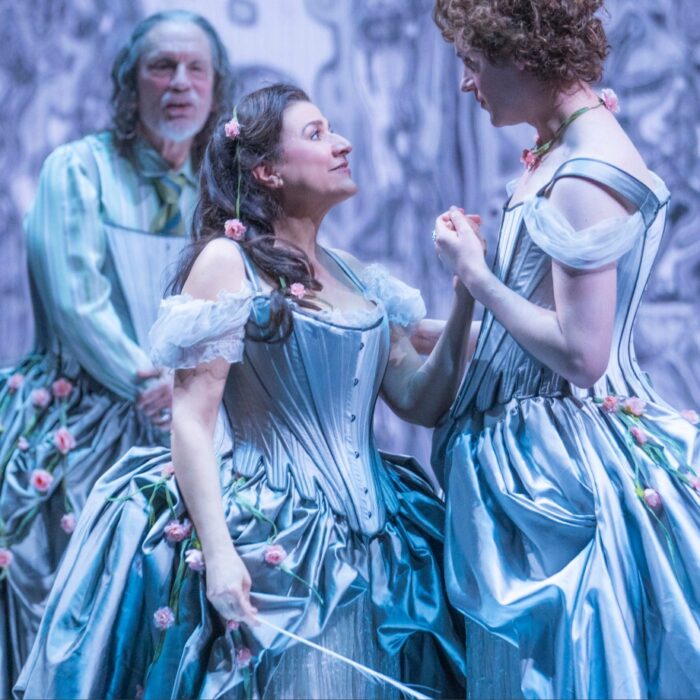
Metropolitan Opera 2016-17 Review – Der Fliegende Holländer: Amber Wagner & Michael Volle Deliver Complex Performances In Cathartic Season Send-Off
By David SalazarThis is a review for the final performance of the run, which took place on May 12, 2017.
The first opera I saw during the Metropolitan Opera’s 2016-17 season was Richard Wagner’s “Tristan und Isolde.” So it was only fitting that the last one I saw this season was “Der Fliegende Holländer,” the first to truly establish the composer as the force he would go on to become.
The Metropolitan Opera placed great emphasis on this late-season revival because of the man leading the orchestra, music director designate Yannick Nézet-Séguin. I will admit that I haven’t always been the incoming music director’s staunchest advocate, but his work on Friday night completely altered my perception of what he is capable of.
High Hopes for the New Maestro
For one, his sense of balance with Wagner’s tempestuous score was spot on. There was never one moment where he drowned out a singer, which allowed Wagner’s text to remain audible throughout the entire evening. He also interacted with his singers quite beautifully. At one point during the Steuermann’s solo, the “wind” motif rushed in as tenor Ben Bliss finished a phrase. The tenor seemed shocked by the sudden swirl of sound, and he rocked back and forth as if the “wind” from the orchestra was hurling at him. As Amber Wagner powered through the end of her famed ballad, the basses in the orchestra were particularly prominent, her potent and riveting statement taking on an ominous hue.
During the Dutchman’s opening and closing statements, it was bass-baritone Michael Volle and his vocal strength and power that drove the orchestra’s increasing outbursts, not the other way around. I truly felt that Nézet-Séguin had an incredible connection with the artists onstage that worked in consort the way chamber musicians breathe together.
The overture is always a major point of reference for any conductor taking on this work and the French-Canadian maestro was breathtaking in his whirlwind interpretation. The overture kicked off with a massive punch so vicious you immediately sensed the tumultuous storm at sea. Throughout this majestic tone poem, I truly felt immersed at sea, the clarity of sound from around the orchestra, whether it be the rumbling base, the chromatic violin runs and the interjections from the wind and brass, there was a sense of organized chaos everywhere.
But then he managed to find a delicate balance with some of the opera’s lighter passages, most notably Daland’s gorgeous aria or the female chorus. Here there was a tenderness of sound that brought sunshine to the Sturm und Drang that dominates the entire work.
This performance alone excited me for the artistry that Nézet-Séguin could bring to the Met at the peak years of his career and I am already looking forward to his “Parsifal” next season.
The Dominant Diva
The cast was fantastic from top to bottom. For me, the night was dominated by the performance of Amber Wagner. The American soprano has one of the biggest voices I heard all season, but she showed a wide range of vocal colors to complement a wonderful performance. Senta’s ballad is one of the most blatantly structured pieces ever written by the composer, the solo passaged set up in a 3×3 structure, three distinct stanzas with three distinct sections established by differing melodies. The first part has accented downbeats that are separated from the remainder of the phrase. The chromatic strings herald in the second, during which Senta repeatedly utters “Johohe” as she expresses the curse of the Dutchman. The final section, lyric in nature emphasizes his salvation. During the third and final stanza, Wagner adds a nice twist to the proceedings that drives it home. Amber Wagner provided the vocal and dramatic highlight of the evening in this aria, her voice taking on completely different colors in each of the sections. Her opening “Johohe” were airy in sound, giving the piece an eerie opening that cemented the sense that Senta was an outsider. The opening “Traft ihr das schift” and every section that mimicked it thereafter was met with stern accents at the start of the phrase and boisterous sound. Her final interpretation of this section was quiet and delicate in its approach, each phrase slowly melting away.
When the strings ushered in the second part of the stanzas, her voice would shift to a darker color, the tension growing as her vibrato quickened. Then as it felt as if she was building up into an emotional storm, her timbre would sweeten and the phrasing would lengthen. Her lingering on each phrase emphasized Senta’s affinity with becoming the Dutchman’s angel. She was even more expansive with her phrasing in the second repetition of this section.
Of course, the final stanza features the female chorus, their quiet and shimmering sound almost celestials. Then suddenly Senta plunges into the most valedictory statement in the opera, proclaiming that she will save the Dutchman. Here Amber Wagner’s voice roared with power into the theater, the clarity of sound and visceral power giving me goosebumps.
During the first section of the duet, her voice soared with brighter timbre as she reveled in seeing the Dutchman for the first time. As that first portion of the passage drew to its climax, her soprano, with ever-intense vibrato and luxurious sound, melded wonderfully with Volle’s, their musical unification cathartic. The end of the duet was also quite visceral in her whole-hearted attacks on the high notes. Her final phrase of triumph, her voice blasting through the hall even from all the way upstage, was also a victory for her performance in this tremendously treacherous role.
A Complex Hero
As the “Holländer” Michael Volle showcase a smaller sound, but one capable of drawing you in and holding you with him from word to word. His first line of text “Die frist ist im (The time is up)” was sung from high up and out of view, but he delivered those tragic and yet foreshadowing words quietly and hesitantly, immediately delivering a sense of trepidation and insecurity about the character. We were already compelled to him as a vulnerable being. As he descended the stairs, his voice seemed to grow in strength, the sound fuller and with a bitter edge. The consonants started to become more pronounced and as that opening monologue grew in its violence, so too did Volle’s sound grow brittle and jagged. At times both he and the orchestra seemed to be in a battle of wills, reminding us that the Holländer’s cruel fate was tied to the ocean and that it was ultimately his mortal enemy. But as he prayed to his angel, laying on a precarious, elevated staircase high above the stage, his voice lightened to a muted tone, his legato slender. The bitterness from before suddenly gave off a sense of heartbreak mixed with hope. And then suddenly he erupted once more with even more violent and jagged phrasing, the orchestra’s tidal waves of sound growing rougher and rougher.
During the ensuing duet with Daland, Volle was firmer in his portrayal, the Dutchman’s only major emotional outburst coming when he demanded Daland’s daughter to be his wife. But in this exchange, we saw a darker and manipulative edge to the main character, Volle’s stern stare, and his nonchalant manipulation unlocking yet another layer in a complex characterization.
His initial steps toward Senta added to this fascination, Volle’s steely stare leaving us guessing as to his real intentions. But then he opened his mouth and started to sing “Wie aus der Ferne längst verging-ner Zeiten” and his voice shifted into a different color we hadn’t heard to this point. It was a warmer hue, his legato line tender as he slowly expressed the joy he was feeling. Wagner famously noted that he wanted his operas to be sung in the bel canto style (not literally but with that same breadth of line and vocal finesse). Volle did him proud in this section.
In that final moment of the opera, when he rains down his omens on poor Senta, Volle took his vitriolic singing to another level. Here every phrase was like a dagger, his vibrato funneling swiftly on extended notes and his attacks on words forceful. The dark side had taken over and it was scary. But most importantly, we could feel the anguish of his destroyed soul, making it impossible not to feel for him and thus make Senta’s final decision all the more epiphanic.
A Colorful Cast
As Erik, tenor AJ Glueckert also exhibited a beauty of line, his legato polished and resonant throughout his two major sections. His famous aria was a plea, Glueckert’s sound phrasing growing more and more pained as he begged Senta to recall their pledge of love. It all beautifully climaxed in the cadenza, the tenor’s voice ringing through the theater in a naked cry of pain.
Franz-Josef Selig gave us comedy and fatherly gentleness as Daland. As Captain, his voice had a harsher edge as he ordered the men around. He was an imposing figure in these moments. But then he turned into a puppet in the Dutchman’s hands, his bass suddenly a bit brighter and more “hollow” in its timbre as he chased the gold all around the stage. But his famed aria”Mögst du, mein Kind, den fremden Mann willkommen heissen,” saw the German bass sing with polished legato and such care with each phrase. He caressed each vocal line as he talked to Senta, and even in passages where he indicated his interest in wealth, it was impossible to feel anything but a fatherly love.
Ben Bliss made quite a musical statement out of the Steuermann’s aria, his elegant and flowing tenor growing softer and softer with each repetition of the main melody as he succumbed to sleep. In the final scene of the opera, his timbre took on a wilder and more erratic style to express Steuermann’s inebriated state.
Dolora Zajick depicted the small role of Mary with snarl in earlier sections but then sang with delicacy in addressing herself to Senta, suggesting special care for the young girl.
The men and women’s chorus also put in a wonderful shift. The opening chorus of the opera was visceral in its sense of musical precision, the men’s voices joining as one. The men tasked with being the Dutchman’s crew imbued murkier tones in their passages, the more muted tones chilling in their ability to suggest the supernatural. The women were breathtaking, particularly in their unified coloratura “laughs” that drew mirror reactions from the audience.
Visual Elegance, One Last Time
August Everding’s production seems to remain a crowd pleaser as evidenced by the audience’s effusive applause as the first curtain rose. It is elegant visually in its ability to juxtapose the two exterior scenes with the middle one, emphasizing the external turmoil of the characters with the inner balance found when Senta and Holländer finally meet. The sets of the first and last acts immediately lead the eye to stage right, with stairs and the top portion of Daland’s ship constructed on these parts of the stage. In each of these, the Dutchman’s shift floats on stage left, the red anchor and rising and falling staircase our only visual cue of the mystical ship. But the second act is precisely proportioned, the color scheme consistent throughout. Only Senta seems out of place, but that wrong is righted when she meets the love of her life. During this duet, the lighting turns blue and the entire world disappears as the two stand in balance on stage together. While it is true that performers are often left static in this stage design, its subtle elegance and realism are well executed.
In all, this was the perfect way to end the 2016-17 season. Wagner’s early masterwork is likely to get a new production in coming seasons, and if this is the case, this cast, led by a vibrant Nézet-Séguin, was a perfect send-off.


